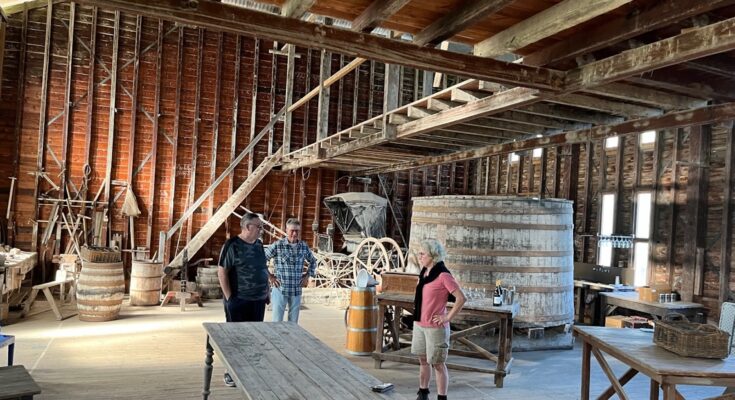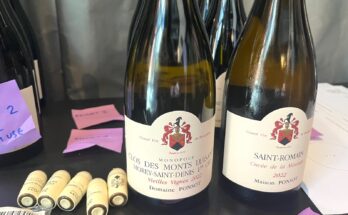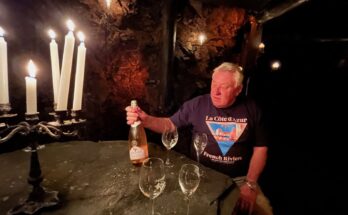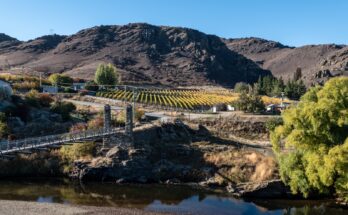It is my first visit to the Yarra Valley, and I really notice a difference on this Saturday, with the day-trippers filling both the roads and Tasting Rooms across the region. Today though I’m at Yeringberg, who are definitely not on the Tourist Trail, with no Cellar door. I start by having a walk with owner and winemaker Sandra de Pury, through the winery downstairs and then head upstairs for a tasting.
I’d looked up the meaning or origins of the word Yarra – and alongside the aboriginal context, the names of the family I’m visiting today cropped up. In the 1850s, the region was on the bustling route to the Warburton goldfields. Vines were first planted in 1838 by the Ryrie brothers, on their property that was known as Chateau Yering. Viticulture spread rapidly through the 1860s and 1870s, led by the early settlers including the de Castella and de Pury families.
Sandra de Pury’s great-grandfather bought the property in 1866 – a long time ago! The land was named Yeringberg – meaning the hill above Yering. The property is 1400 acres, with sheep and cattle as well as vines. Wine has been made here since the 1860s and until 1921, when Sandra’s grandfather pulled the vineyard out – alongside the whole of the Yarra Valley – because he couldn’t sell wine. Sandra’s father replanted in the 1960’s. They were the only famous wine-producing property that was still in the same hands.
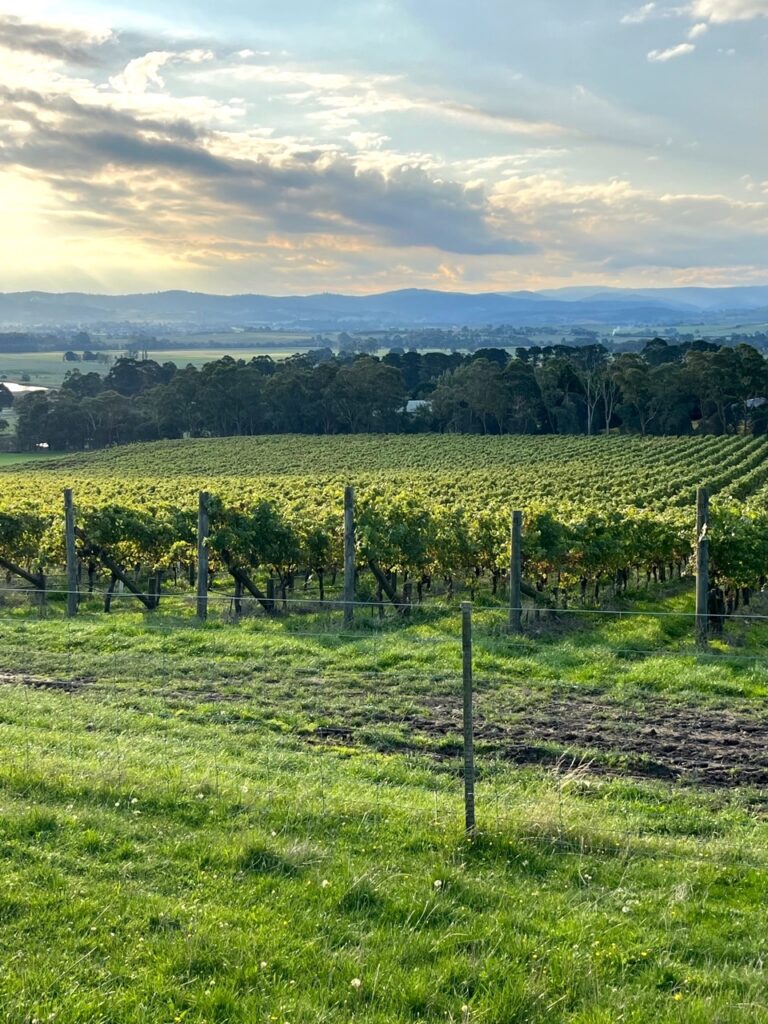
A lot of their grapes are sold on contract currently, but there are hopes that the next generation will be making it into their own wine. Most of the vineyards are on the North-west slopes, including their oldest vines. New planting is also now happening – Pinot Noir vines on South and East-facing slopes, as the climate warms. Vintage has slowly crept earlier and earlier over the last twenty years. They have been small – making wine from nine acres – for a long time. The winery is small, and they do about 35 tonnes – a very hand-made operation.
On an old door, are various prize cards from local shows. There’s one from 1901. The ‘more important ones’ from International shows were kept in the main house, and were lost in a fire. Through the door, you step into a cellar from the 1860s that stores and matures the red wines. Everything spends 18 months to two years in barrel. Other than putting a concrete floor down, much is the same as it would have been back in the day. The stillage is the one that Sandra’s Great-grandfather was using.
Of course back then they didn’t have electricity, or head torches, or plastic buckets – the things that we just take for granted now – there are some old candleholders hanging on the wall. Once the wine trade proved successful by the 1880s, the rest of the building was added – the floor above, and under the cellar. The stone that was used was quarried just a hundred metres away where the Pinot Noir vineyard is. Hand-cut beams that are simply massive. You wonder how these things could be put together back then. The place is quite extraordinary.
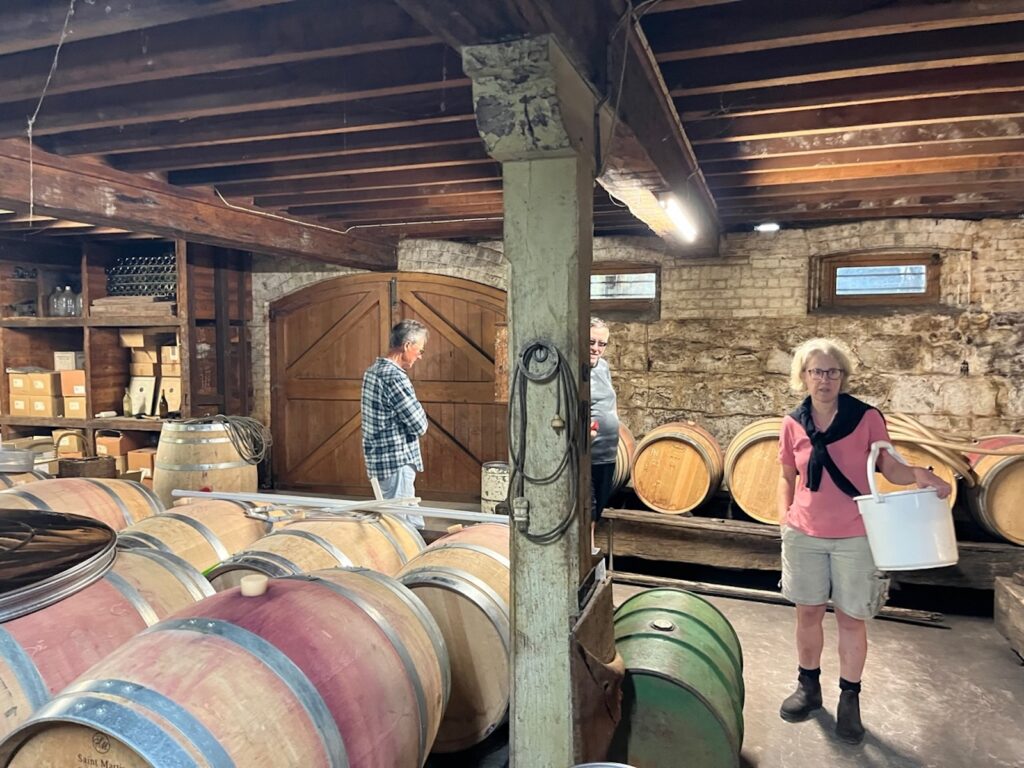
They’ve started to make a rosé in the last few years, from Shiraz and Cabernet. Juice gets processed upstairs and is fed down to the lower level tanks, where it is settled, then into barrel. This year is the first crop off some re-planted vines, which are kept separate, in a juggling game in the winery. Sandra will keep tasting them over the months, to work out what she thinks of them, and experiment with them. An example this year was two tonnes of Marsanne left on skins for two weeks, to see how that looked. But the full extent of this years Chardonnay is six hogsheads – down from about eight in a normal year.
I ask about the oak, and battonage. Sandra replies: “We’ve been using Taransaud for decades, and they’re very reliable. A subtle oak. We use about 30% new barrels, and we’re doing about 30% malo now as well – with those new barrels. We stir every couple of weeks. A lot of Chardonnay making now is very pulled-back. I personally prefer Chardonnay with a bit of flavour. Not over the top. Whereas the Marsanne/Rousanne is fermented in tank, let it settle, goes into old barrels on fine lees, and I don’t stir it. And add sulphur straightaway to block the malo – even though it spends a year in barrel.
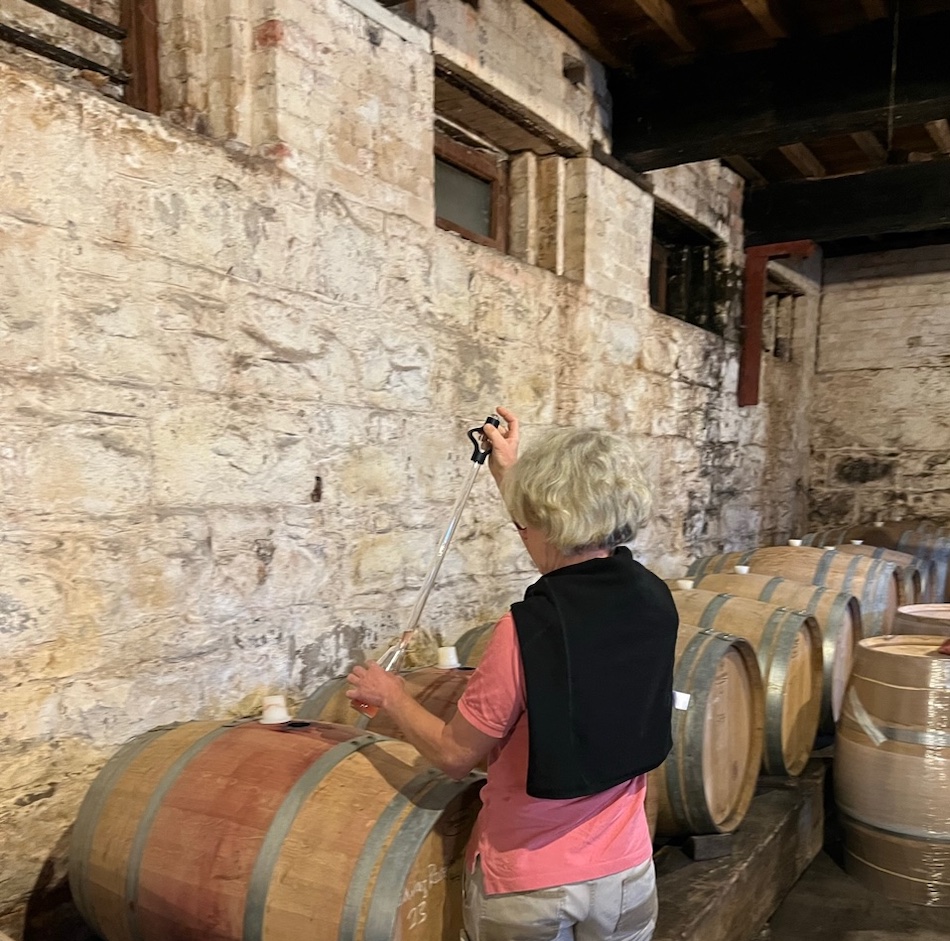
And the Viognier is different again. I settle that in tank overnight and it goes straight to barrel, wild fermentation, and some does malo, some doesn’t. The complexity we get is helped by picking at three different times, so we get different points of ripeness. The early pick usually has a fair bit of acidity, and the late pick can be about 15% alcohol at that time. Blend it at the end of the year”.
‘Upstairs’ is the original winery that was built, and the last vintage was 1921. Wooden floor, no drainage, no temperature control whatsoever. It gets quite hot in Summer and cold in Winter. Grapes would arrive on a horse-drawn cart, and get lifted up on a steam-engine powered hoist. Along the top level is a railway line that runs around to a de-stemmer and into the press through a big funnel. Then gravity takes it down to the barrels at ground level. The steam engine also drove the de-stemmer and other parts of the operation. ‘Low-tech’ doesn’t even begin to describe it.
The space is magnificent. Used mostly for Tastings now. Once a year, in spring, there is an event for the Mailing List customers. Sandra explains “I tend to say No to a lot of appointments, because it is a big place, and I live here, and I’m not in the Tourist business. If people want to make an appointment I just say that they have to pay a fee. It’s good, it sorts out the people who really want to come and taste, and the people who don’t.”
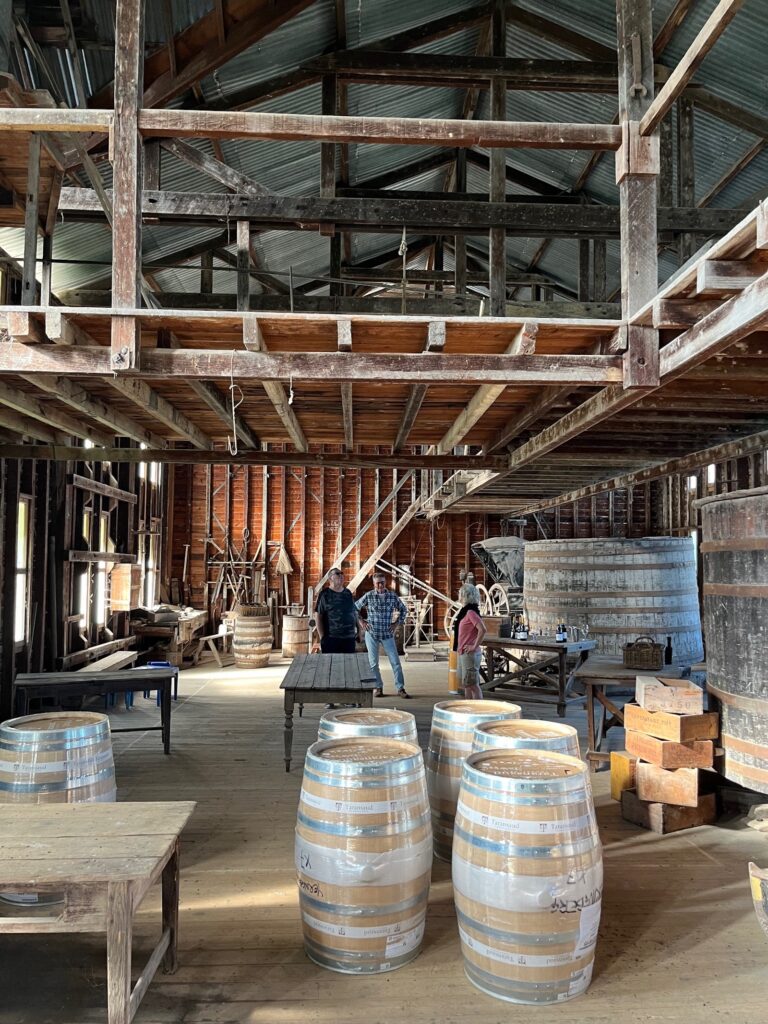
We start on the Marsanne/Rousanne, which is about 60% Marsanne. It is a vineyard blend – whatever those grapevines produce – the Marsanne is usually ten days ahead, but this year they were actually picked on the same day. If the weather is on their side – and this year it certainly wasn’t – they can choose to ripen the grapes until they are a nice well-coloured bronze. The wine is only 12.5%, so not a big wine, but it has got weight. It’s a classic take on a traditional style.
When they moved from using the basket press to the new airbag press, they had to think about how to “not change the style radically because we’ve changed the equipment”. The answer was to not rush too much, so that the older, slower method of having the wine in an overhead tank and gradually feeding it into the Basket press – and the wine, with some maceration and skin contact, that resulted – didn’t lose its personality. This year’s version of the wine was left on skins and the bulk of it pressed after four days, then a portion left longer for two weeks.
They are going to have more fruit off their young vines in the next few years, and there is thought to develop more wine that takes that low-fi, skin-contact angle – maybe a second label. A young-vine label for a younger demographic. Things change. Yeringberg wines all had corks in until about 2005, then diam and finally screwcaps in 2012.
The Viognier 2020 has an exotic lemongrass note on the nose. It is picked in three stages – the first lot slightly under-ripe, the bulk of it perfectly ripe, and then a portion that is left to be really ripe. Sandra has learnt, with Viognier, to ignore the numbers (pH, TA) and trust the taste. “It’s an interesting grape to work with. It changes so quickly on the vine. One day it is chalky and tasteless and three days later you have to pick it. Viognier just wants to have high pH. It’s hard to make Viognier with flavour under 13.5%. By the numbers it should not work. But I’ve tried 8-year old bottles of this recently and it does keep. The Yarra is a great place for Viognier – it has an elegance. It is still a big full-bodied white wine, but there’s some finesse. In fact we didn’t set out to make a Viognier. The vineyard was planted in 1999 as a contract vineyard, selling the fruit for ten years”.
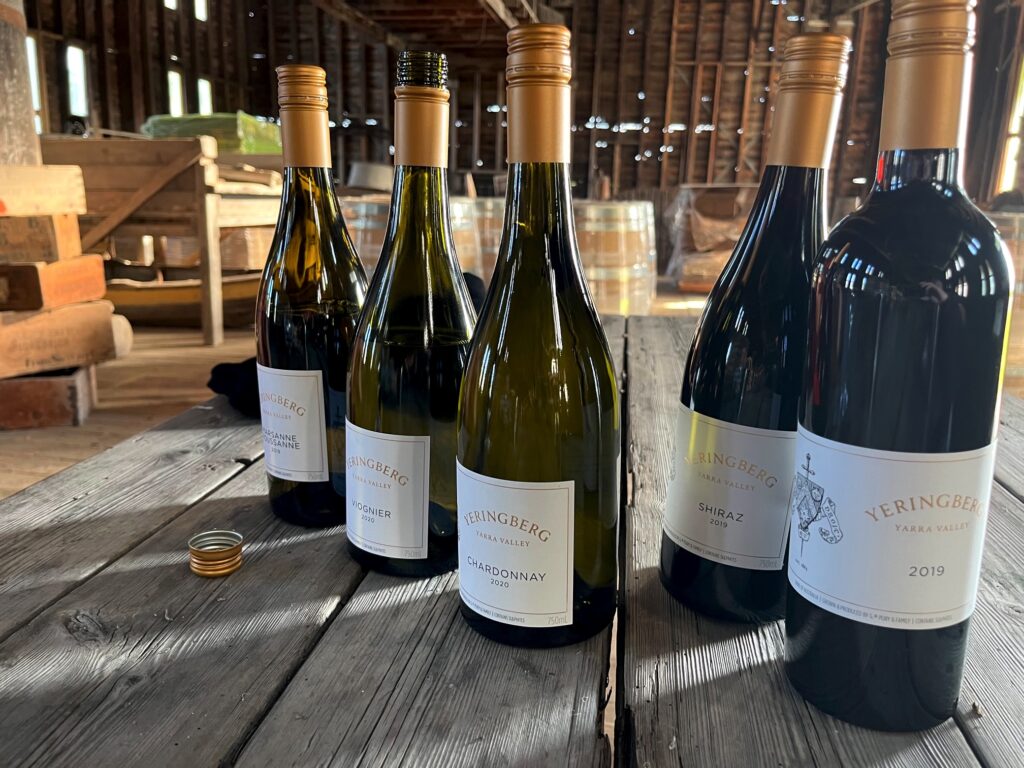
The Chardonnay 2020 has about a third new oak. The Clone is Penfolds 58, planted in the ‘60s. A controlled power, weight and complexity. A mealy texture. I thought the Viognier was great – but this! Wow. I buy a bottle. The Shiraz 2019 comes up next, from vines that were replanted in 1999. Boysenberry, blueberry, salami, savoury notes on top of the plush fruit. The wine seems ready now. I imagine that ten years will see this improve; but if you wanted to drink it right now, I’d see no problem in that. It is a head-scratcher – how can this be this good already? It is also obviously varietally Syrah – perhaps in a Cote Rotie style.
The eponymous wine ‘Yeringberg’ is made from Cabernet Sauvignon, Cabernet Franc, Merlot, Malbec and Petit Verdot. It is around 60% Cabernet Sauvignon. The varietals are fermented separately like the Marsanne blend – it is another ‘vineyard blend’. In some years they make a separate Cabernet Sauvignon, but not from the vineyards that make up the Yeringberg wine. In the new plantings, Sandra has put in a higher proportion of Cabernet Franc, so that it will be reflected in the Yeringberg blend – in ten years time! It has a youthful prettiness amidst the power and concentration.
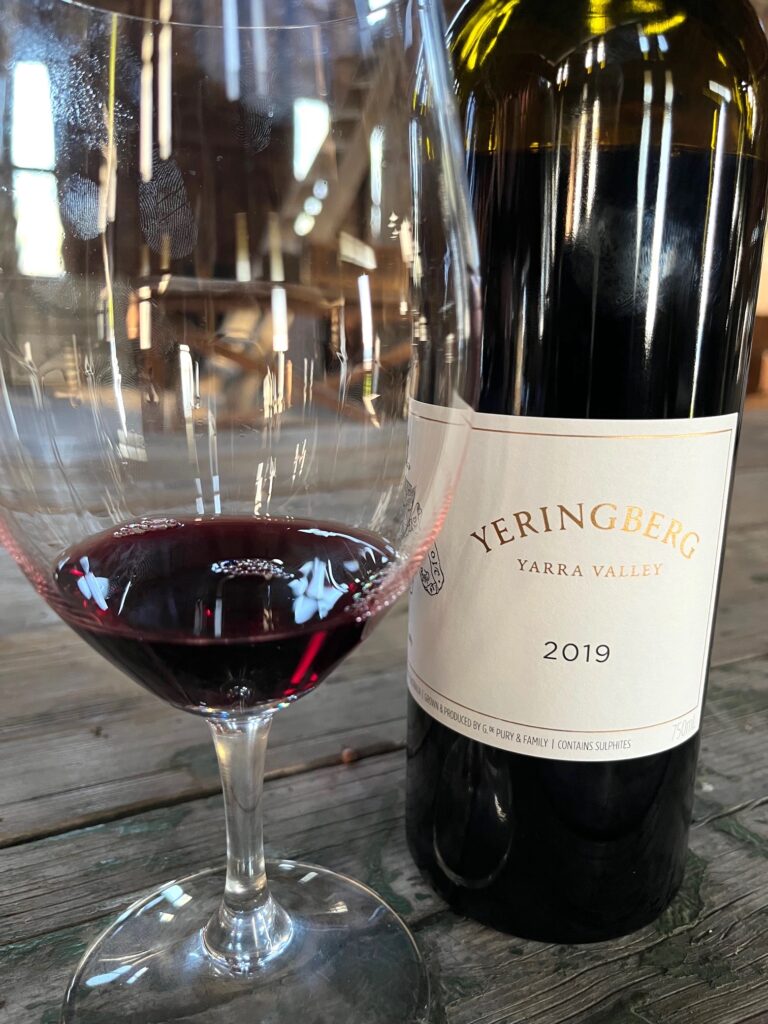
They have tried to retain stocks – a pallet of 2015, plus the 2017s that they got back from the distributor during COVID lockdowns as all the restaurants stopped opening, and ordering. The Marsanne/Rousanne will be a lovely wine to keep, but Sandra notes that with 2017 being a cool year – the 2019 Yeringberg is drinking better than the 2017 (so far). A recently-opened 2010 of the Marsanne/Rousanne white was “fresh as a daisy”. Also Sandra comments that “The Viognier is probably best in the first few years of its life. But I know the Rhône Viogniers can look fabulous at twenty years old.”
I wanted to ask about the future direction. Is Sandra confident of making wines to play in a younger market – away from the pedigree and heritage of the current Yeringberg wines? Does she have an assistant who would take that on?
<laughs> “An assistant? There’s just me – in the winemaking team. To be quite honest, I don’t have a clue what I’m doing! I’m just playing around with different things and we’ll see what it looks like. I mean, I make wine according to what I like. If I don’t like it I’m not going to bottle it. I’m trying to work out what I’m going to do with the fruit from those young vines, because I can’t just pump up the quantities of all these with young vine fruit. Some of the fruit off the young Cabernet vines was beautiful – extraordinary. But we’ll see. My thinking is to develop a red and a white wine and maybe a skins-y wine that are priced at Wine bar prices. Do a label that is Off-Broadway – a side label that is not traditional.
We’ve had this long history, but the generations have been so long. My Grandfather was sixty when my father was born – hugely long generations. The passing down the knowledge when you only meet the generation before is quite interesting. I’d love to sit around a table with my Great Grandfather and Grandfather and pick their brains! Now it is quite good, because my parents are ninety but the next generation – my kids – are all in their late teens or early twenties.”
I ask if winemaking was in the blood, or was it something that Sandra didn’t set out to do?
“We were all encouraged to finish school, leave home and get out of here. The winemaking was very small when we were growing up. It started off almost in the kitchen. I actually started Medicine when I left school. Dropped out of that and travelled for a while. Then I started Arts and dropped out of that. I was a bit confused about what to do – as I wasn’t really cut out for study.
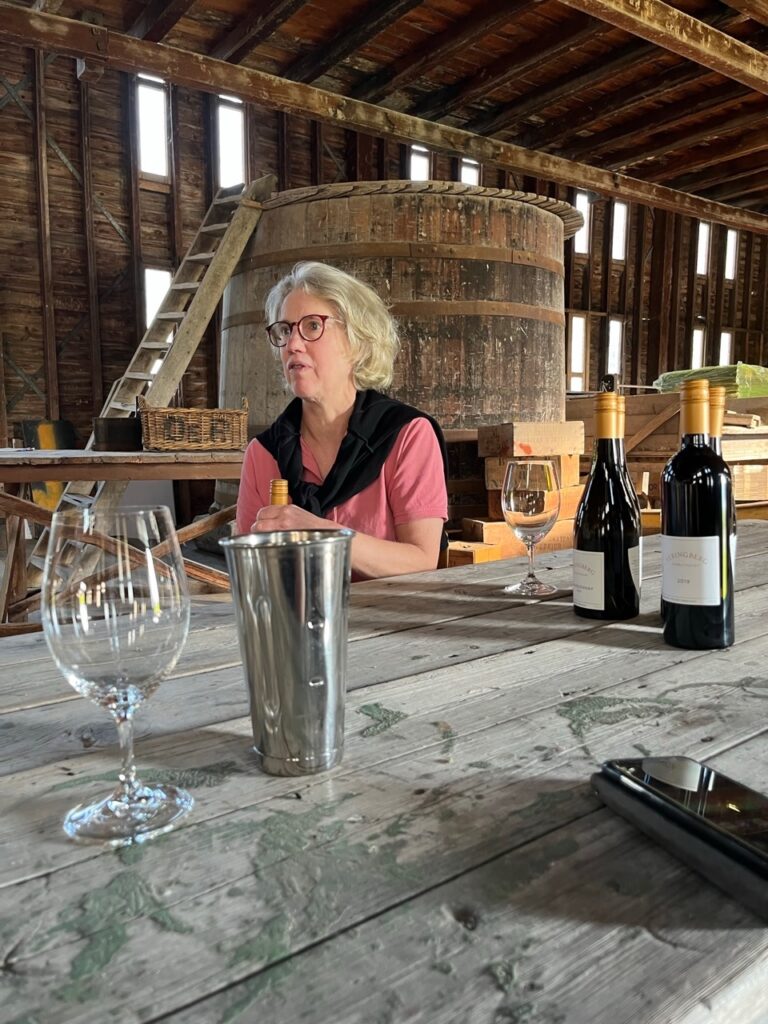
My part-time job all the way through was always in kitchens. I’d done an apprenticeship in the best restaurant in Melbourne, so when I travelled around the world for ten years I was cooking in interesting places. Always high-end French food. And after blagging my way onto an MBA, I then fell into Management Consulting – because that’s what you do. It was interesting, but not me. I started studying winemaking part-time. And came back here. Very circuitous. My skillset is good for running a small business. Being a chef is all about tasting – and time management. Having a dozen pots going at once, to produce.. this. My brother works here full-time as well, looking after the animal side and the viticulture. He left school and did a PHD in plant physiology, and was working in Belgium looking at Greenhouse effects, then came back here. So we’re reasonably over-qualified farmers”.

